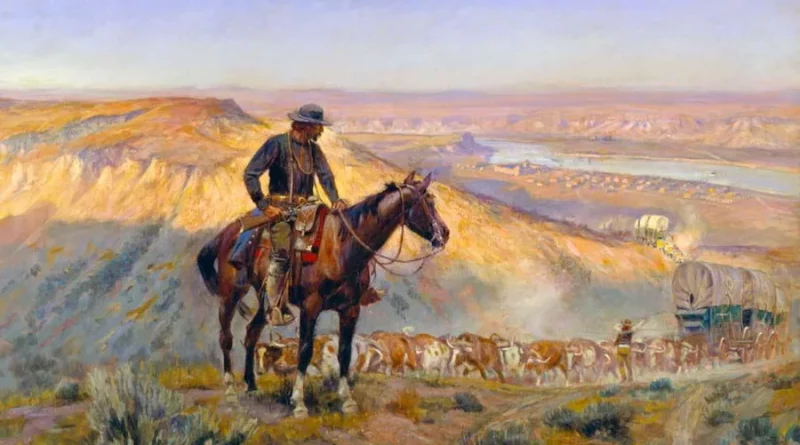A Superb Storyteller: Artworks by Charles Marion Russell
Charles Marion Russell was a talented storyteller and an exceptional painter, illustrator, and sculptor. Russell was born on March 1864, in Missouri, near the western frontier’s expanding population. He created his conceptions of the American West by adorning his schoolbooks with illustrations of cowboys and Native Americans as a child.
He moved to Montana just before turning 16 and spent the next eleven years doing various rancher jobs. He drew in his spare time and quickly established himself as an artist in the community. His firsthand ranching experience and in-depth understanding of outdoor living contributed to the particular realism that was a hallmark of his works.
His amazing works
During his lifetime, Charles Russell artist produced almost 4,000 pieces of art. For 46 years, his admiration of Montana and the lifestyle he had seen and experienced there influenced both his work and personal philosophy. He had an exceptional talent for capturing, in paint, ink, bronze, and wax, the individuals and occurrences of the West in his art.
His art was considered to be that of a storyteller. Charlie’s contagious humor, artistic storytelling, activism, and illustrated “paper talk” letters uphold a priceless heritage. A broad inner group which included family, Great Falls neighbors, contemporary painters, Northern Plains indigenous tribes, and other celebrities like Will Rogers, all showed loyalty to Charlie.
Here is a look at some of his compositions that show how talented he was at telling stories.
Roping a Wolf

It is possible to trace the development of Russell’s opinions on the practice once known as “wolfing” from these early works and toward the conclusion of his career. In response to attacks on cattle in the late 19th century, a crusade against the big grey wolf was launched, and as time passed, the practice of killing, poisoning, and trapping these wolves came to be known as “wolfing.”
In the off-season, inexperienced cowboys such as Russell would engage in these activities since several states offered rewards for the apprehension and execution of grey wolves. Russell later expressed guilt over his involvement in the poisoning of wolves during his cowboy career, a decision he claimed he would live to regret.
Around 25% of Russell’s subject matter later in his tenure was animals, demonstrating his passion for natural and animal issues. Even the nickname “the Harmless Hunter” was given to the amazing artist.
This incredible painting tells the tale of what Russell went through while participating in these wolf roping exercises. Whether depicting great drama and perilous situations involving roping cattle, mustangs, wolves, or grizzlies, these scenes captured Russell’s mind throughout his artistic career.
The Buffalo Hunt
Charles Marion Russell’s painting of a buffalo hunt is a stunning and powerful piece of art. In the picture, a group of Native Americans is pursuing a herd of buffaloes on horses. Native Americans yell and holler in delight as the buffaloes flee in fear. The background of this piece of art is mountains and rolling hills, which are situated in the American West.
The rich colors and movement in the picture give it much life. A story of Native American culture and way of life is depicted in the painting. It is a powerful and poignant piece of art. Russell was a skilled storyteller and artist, as evidenced by his ability to produce this painting using the tales he had heard from his native Indian acquaintances.
Laugh Kills Lonesome
Charles Marion Russell depicts the joy of laughter and its capacity to drive away loneliness in this picture. A group of individuals can be seen conversing and laughing while gathering around a campfire in the painting. The fire’s bright flames highlight their joyful expressions, and their laughter keeps the night’s gloom at bay.
This sight is devoid of loneliness because the force of laughter has driven it away. This is one of the only two nighttime artworks in the Russell collection, and it was created a year before his passing. It’s also the most overtly emotive painting. Russell increasingly focused on the past as he struggled with ill health and lived in a 20th-century West that was changing in ways he did not like.
No artwork more effectively captures his lamentation for a bygone era and location—the frontier he had adored when he first came to Montana. As a skilled storyteller, Russell tries to illustrate the fun times he had while still a young cowboy who was healthy and active enough to travel with his contemporaries.
The Mad Cow-When Cowboys Are Troubled
Routine cow work dominated this era. But this duty might sometimes be dangerous, and Russell painted this particular scenario multiple times. Finally, the cow, which the cowboy on the right had roped by the heel, surged at the rider and horse, pushing them up against the edge of a cut bank.
As the cowboy rushes away from his saddle to escape getting impaled or smothered by his rearing animal, he goes for his handgun. However, Russell suggests the cowboy will have greater difficulties because his pistol hand will soon become entangled in the rope’s loop. In addition, the third rider cannot assist him because he is too busy controlling his horse.
The composition is compact, and the action is tense. But, as a good storyteller, Charles Russell wanted to tell us what occasionally happened when the cowboys were out there herding, and this painting does a beautiful job.
Conclusion
Charles Marion Russell created more than 4,000 recorded works, including oil paintings, watercolors, sculptures, and writings, that expertly portrayed the spirit and creativity of the American West. His paintings further depicted the good storyteller he was.
Russell accomplished this by creating an academic visual record honoring Western narratives, sweeping landscapes, and magnificent wildlife images. His spirit endures even if his work is regarded as historic by enthusiasts.
Read also: Morgan Anastasia Gaddis

